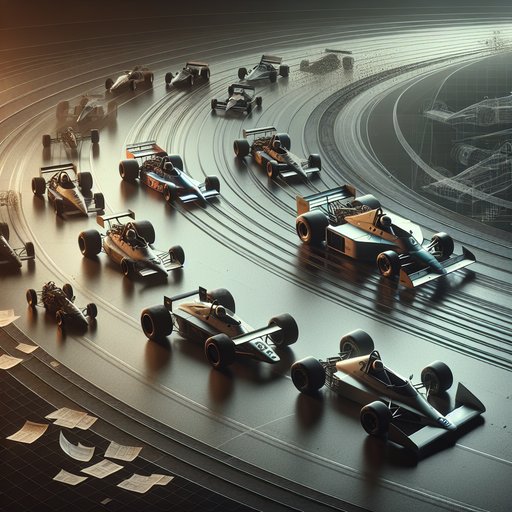
Formula 1 evolves by decree. Each sweeping rewrite of the regulations—whether banning ground effect in the 1980s, outlawing electronic driver aids in the 1990s, ushering in hybrids in 2014, or enforcing cost caps in the 2020s—reshapes the competitive map and the technology beneath it. Teams do not merely comply; they reinterpret, retool, and reorganize, turning constraints into competitive advantage. The history of the sport is best understood through these inflection points, where safety, spectacle, and sustainability demands converge and the fastest thinkers gain a crucial head start.
Studying major rule changes reveals the engine of motorsport evolution because Formula 1 codifies innovation by limiting it. The rulebook frames safety, cost, and entertainment priorities, and teams respond by allocating talent, tools, and time to new performance frontiers. Constraints also homogenize some solutions, making marginal gains harder to find and more valuable. The cycle is continuous: regulations close one door and open another, and the most successful teams treat every reset as an opportunity to redefine their car and their processes.
The first great modern reset came with the 1983 ban on sliding-skirt ground effect and the requirement for flat bottoms, following an era of extreme downforce and volatile ride control. Underbody suction had transformed cornering speeds in the late 1970s, but bumps and pitch sensitivity made cars difficult to drive and police. Removing full ground effect shifted emphasis back to wings, diffuser geometry within tighter limits, and chassis stiffness. Carbon-fiber monocoques—pioneered by McLaren in 1981—rapidly became the norm as teams chased structural rigidity to stabilize aero platforms and recover lost grip.
The next landmark change targeted electronics. After a peak in active suspension, traction control, and other driver aids in the early 1990s—epitomized by Williams’s dominant FW14B and FW15C—the FIA banned such systems for 1994. Enforcement proved challenging, and the tension between ingenuity and oversight ultimately led to the adoption of a standard ECU in 2008. Teams responded by refining conventional suspension kinematics, optimizing aero maps across ride heights, and developing drivability through engine calibration within the rules.
As regulations tightened, the development race shifted toward integration—making mechanical, aerodynamic, and software elements work as a coherent whole. Tyre and aerodynamic resets repeatedly jumbled the order and demanded new philosophies. In 1998, cars became narrower and ran on grooved tyres, incentivizing high-efficiency aerodynamics, complex bargeboards, and sharper yaw stability. A bold 2005 rule that required one set of tyres to last the race forced teams and suppliers to prioritize durability and thermal control, only to be reversed a year later.
The 2009 overhaul brought slimmer wings, cleaner bodywork, slick tyres, and unintended opportunity: Brawn GP, Toyota, and Williams exploited a double-diffuser loophole to create decisive downforce, prompting rivals to re-architect their rear ends and leading to a targeted ban for 2011. Even measures designed to improve racing reshaped engineering choices. The F-duct’s driver-operated stalling device briefly thrived in 2010 before being outlawed, with DRS replacing it in 2011 and pushing teams to manage downforce and drag across activation zones. Exhaust-blown diffusers became the hallmark of 2010–2011, marrying engine maps to aero performance until mid-2011 clampdowns and subsequent exhaust location rules throttled the effect.
Other clever systems—mass dampers in 2006 and FRIC interlinked suspension in 2014—were curtailed as the FIA clarified intent. Each intervention forced teams to reweight their development: when one gain vanished, attention flowed to tyres, brake migration, or micro-aero around the floor and front wing. The 2014 hybrid power units marked a generational pivot that rewired car design and racecraft. The 1.6-liter V6 turbo with MGU-K and MGU-H, fuel-flow limits, and strict energy budgets moved the performance frontier to thermal efficiency, control software, and packaging.
Cooling architecture and tight “coke-bottle” rear ends became as decisive as raw power, while energy deployment strategies changed how drivers attacked and defended. By the early 2020s, peak efficiency exceeded 50%—remarkable for a racing engine—and software integration between chassis and power unit defined the feel and speed of the car. Partnerships between works teams and manufacturers deepened, aligning factory resources with on-track objectives. A different kind of reset arrived with the 2021 financial regulations and revised sporting framework.
The cost cap narrowed spending disparities and, alongside a sliding-scale aero testing restriction, made efficiency of development a competitive skill. The pandemic-era homologation and token system rewarded clear technical roadmaps, while the 2022 aero rules reintroduced ground-effect floors via Venturi tunnels, simplified wings, and 18-inch tyres. Teams confronted porpoising and bouncing as an emergent phenomenon, answering with stiffer floors, revised suspension geometry, and ride-height strategies, while a mid-2022 directive and 2023 tweaks aimed to control oscillations. Under the cap, choices about update frequency, wind-tunnel hours, and mid-season redesigns became strategic gambles as much as engineering ones.
Across eras, the most adaptable teams built organizations that can switch targets quickly without losing quality. They invest in simulation and correlation because track testing has been restricted for years, making accurate models vital when a new rule set arrives. Design modularity—interchangeable sidepod concepts, alternative cooling layouts, and flexible suspension pick-up points—lets squads pivot when an idea underdelivers without scrapping the car. Processes matter as much as breakthroughs: clear governance, fast decision cycles, and the courage to exploit grey areas, as with double diffusers or dual-axis steering later banned, often separate champions from contenders.
Regulation changes have also improved the sport’s resilience and relevance. Safety-driven chassis rules after 1994, the halo in 2018, and ongoing crash-test advances have saved lives while enabling drivers to race harder. The hybrid era and sustainable fuel pathway, coupled with cost controls, tie Formula 1 to the broader technological and environmental agenda without dulling competition. Meanwhile, the rulebook’s feedback loop—adjusting aero to improve racing, rebalancing costs to protect the grid, and refining technical freedoms to reward ingenuity—keeps performance fresh.
Looking ahead to the next power-unit cycle, the pattern is clear: new constraints will produce new champions, and the smartest responses will again redefine what fast looks like.










































